What Is Line Art? Everything You Need to Know About This Trend
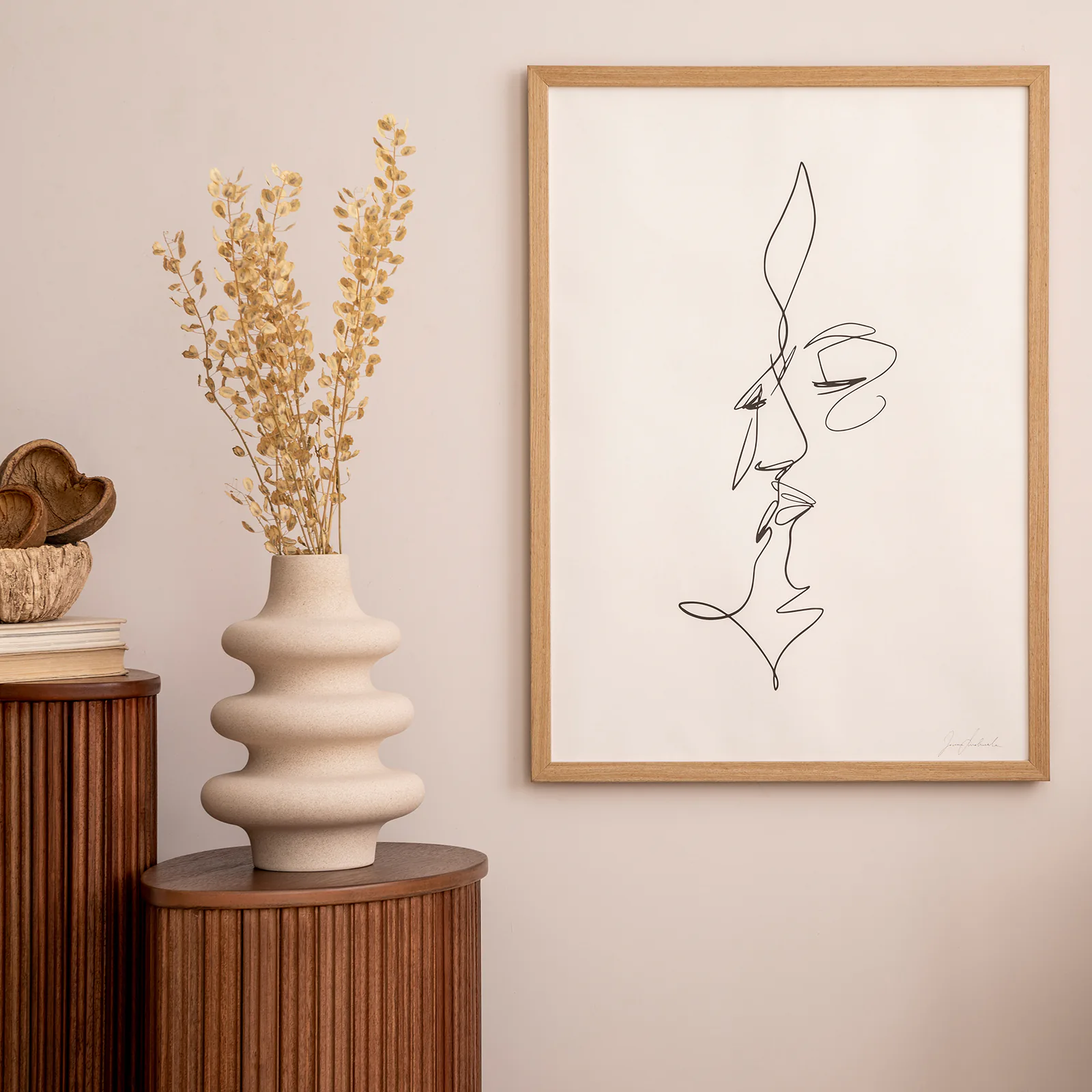
What Is Line Art? Everything You Need to Know About This Trend
Line art captivates with its elegant simplicity, using only lines to create powerful visual statements. This deceptively simple art form has surged in popularity across modern interior design, digital platforms, and fashion. From the walls of art galleries to Instagram feeds and home decor catalogs, these minimalist compositions have become a defining aesthetic of our time.
In this comprehensive guide, we’ll explore what exactly constitutes line art, trace its rich historical roots, examine its various techniques, understand its modern appeal, and provide practical advice for creating your own line drawings. Whether you’re an aspiring artist, design enthusiast, or simply curious about this trending style, you’ll discover why these seemingly simple compositions hold such enduring power and contemporary relevance.
The basics of line art: understanding its definition and history
Line art, in its purest form, is artwork created using distinct straight or curved lines against a typically plain background, without gradations in shade or hue to represent objects, scenes, or figures. Unlike other drawing styles that rely heavily on shading or color to create dimension, line art distills visual expression to its most fundamental element—the line itself.
What makes this style distinctive is its focus on contours, outlines, and the relationship between positive and negative space. The simplicity is deceptive; within these constraints, artists must convey form, movement, emotion, and dimensionality through only the quality, weight, and direction of their lines. This challenge has attracted artists throughout human history, resulting in some of our most enduring visual expressions.
Line art through the ages
The story of linear expression begins with humanity’s earliest artistic endeavors. Cave paintings from Lascaux and Altamira show prehistoric artists using clean, economical lines to depict animals with remarkable accuracy. Ancient Egyptians developed a sophisticated linear style in their hieroglyphics and tomb paintings, creating a visual language that remained consistent for thousands of years.
During the Renaissance, artists like Leonardo da Vinci elevated line drawing to new heights. His anatomical studies demonstrate how precisely controlled linework can capture complex forms. Da Vinci’s famous quote that “simplicity is the ultimate sophistication” could well be the mantra for line art itself.
The early 20th century saw revolutionary approaches to line. Pablo Picasso’s ability to capture a bull’s essence in progressively fewer lines or Henri Matisse’s fluid contour drawings demonstrated how masterful artists could convey maximum meaning through minimal means. Japanese artists had long understood this principle through sumi-e brush painting and ukiyo-e prints, which profoundly influenced Western modernism.
Today’s digital landscape has given line art new dimensions, with vector illustrations, digital line drawings, and minimalist logos becoming ubiquitous in our visual culture. What began on cave walls continues to evolve on tablet screens, demonstrating the timeless appeal of this fundamental artistic approach.
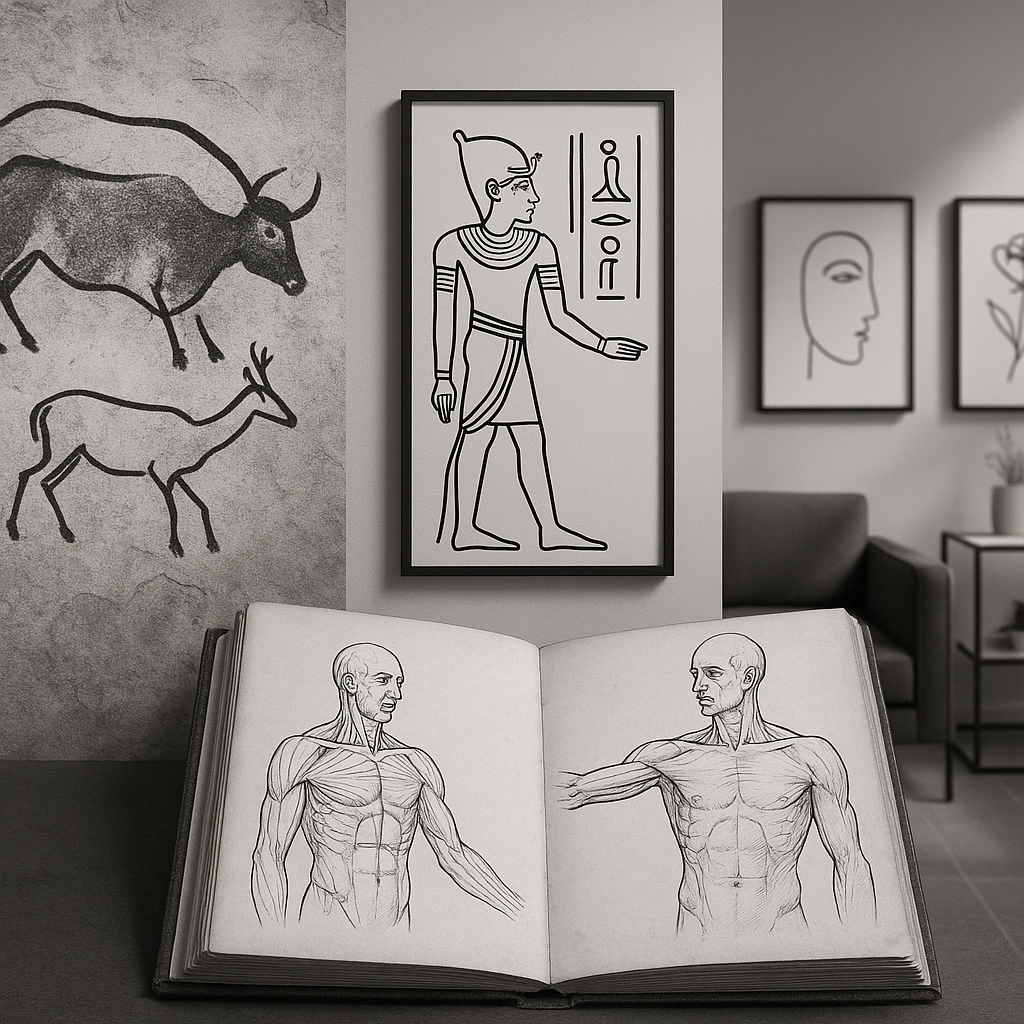
Types and techniques of line art
Line art encompasses a variety of distinct approaches, each with its own characteristic appearance and technical demands. Understanding these different techniques opens up a world of creative possibilities for artists and helps viewers appreciate the skill behind seemingly simple drawings.
Classic line art techniques
Contour/outline drawing: Perhaps the most recognizable form of line art, contour drawing focuses on capturing the edges and outlines of a subject. Blind contour drawing—where artists don’t look at their paper while drawing—is a common exercise that trains observation skills and creates spontaneous, often expressive results.
Continuous line drawing: This challenging technique involves creating an entire image without ever lifting the drawing implement from the surface. The resulting unbroken line creates a sense of flow and movement, often with surprising and dynamic results. Artists like Picasso and Paul Klee mastered this approach, creating complex compositions with a single, meandering line.
Hatching and cross-hatching: These techniques use parallel lines (hatching) or intersecting lines (cross-hatching) to create texture and shadow. The density and direction of these lines control the perceived darkness and texture of an area. Renowned printmakers like Albrecht Dürer achieved remarkable tonal range using only crossed lines.
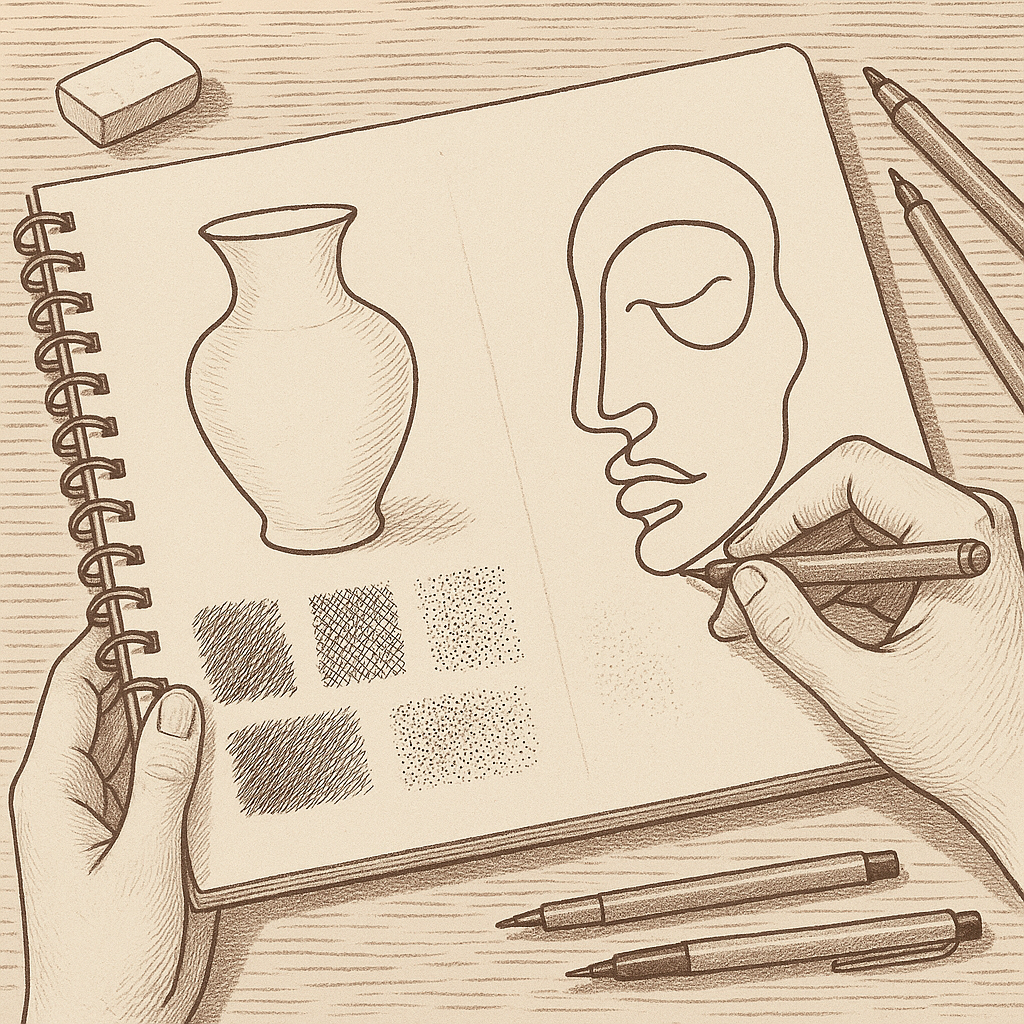
Stippling: Instead of continuous lines, stippling uses countless small dots to create tone and texture. The concentration of dots determines how dark an area appears. This painstaking technique requires patience but produces distinctive results with a unique textural quality that works beautifully in both traditional and abstract line art prints with bold black curves.
Scribble and gesture drawing: These more expressive techniques use loosely controlled, energetic lines to capture the essence or movement of a subject. Gesture drawing particularly focuses on conveying action and form through quick, decisive strokes rather than detailed rendering.
Modern interpretations and applications
Contemporary line art has embraced both digital tools and minimalist aesthetics. Digital artists use tablets and vector programs to create perfectly smooth, scalable line drawings that maintain their clarity at any size—ideal for both digital displays and physical products.
Minimalist line art has become particularly popular in interior design, often featuring simple face profiles, abstract shapes, or botanical forms executed in clean black lines on white backgrounds. These pieces bring a sophisticated yet approachable aesthetic to modern spaces without overwhelming other design elements.
Wire sculptures represent a three-dimensional extension of line art principles, using metal wire to “draw” in space. Artists like Alexander Calder and Ruth Asawa pioneered this approach, creating works that cast intricate shadows and change appearance as viewers move around them.
In graphic design, line art has become central to brand identity systems that need to work across multiple platforms. Simple linear logos and illustrations can maintain their integrity whether displayed on a tiny smartphone screen or a massive billboard.
Why is line art trending? Contemporary appeal and uses
The resurgence of line art in contemporary design reflects broader cultural currents and practical considerations that have aligned to make this style particularly relevant today.
Minimalism continues to dominate interior design sensibilities, with many homeowners and designers embracing “less is more” aesthetics. Line art’s clean, uncluttered appearance makes it a natural fit for these spaces. A simple framed line drawing can add visual interest and personality to a room without disrupting its careful balance or competing with other elements.
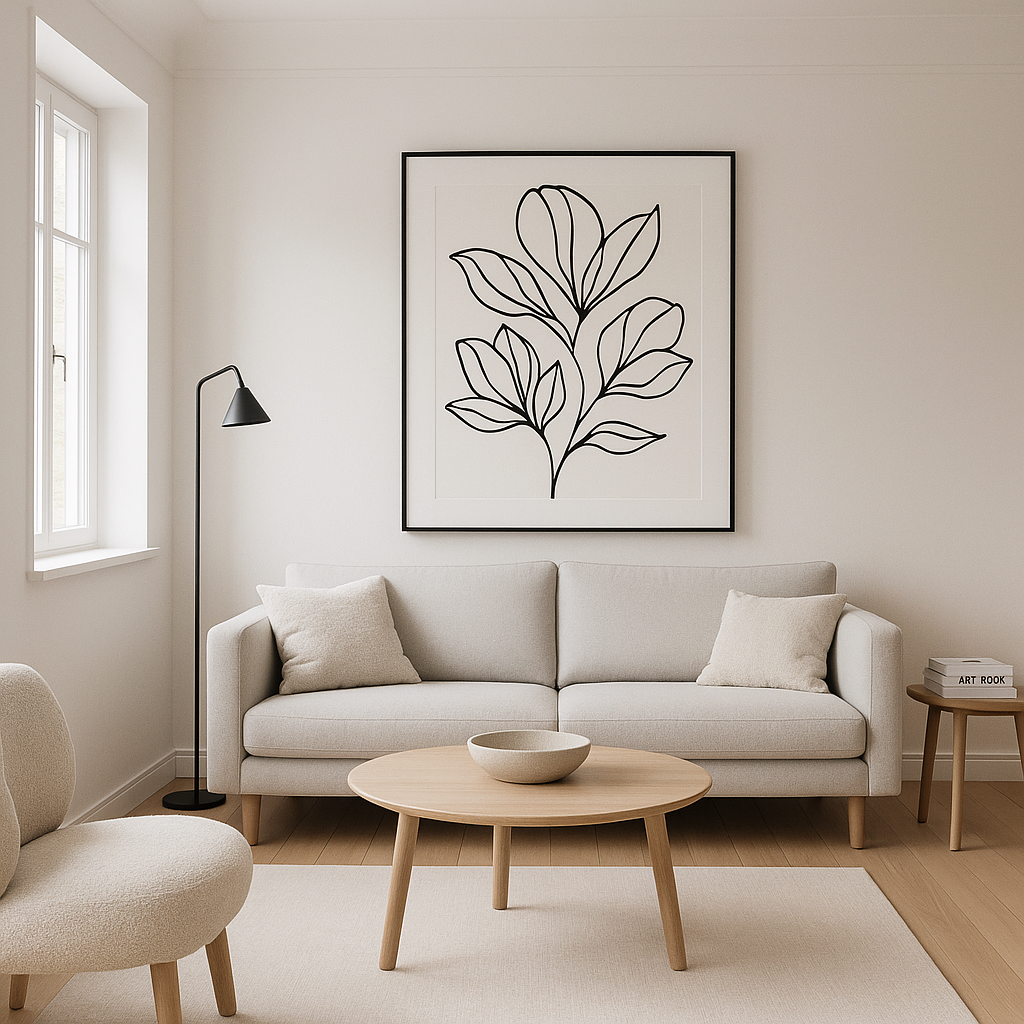
Social media platforms, particularly Instagram and Pinterest, have amplified the trend. The high-contrast nature of black-and-white line drawings translates exceptionally well to digital screens, maintaining impact even when reduced to thumbnail size. This visibility has helped create a feedback loop where increased exposure leads to greater popularity.
The economic accessibility of line art has also contributed to its widespread appeal. Unlike complex, color-saturated artwork that can be expensive to reproduce with fidelity, line art can be printed affordably while maintaining its essential quality. This democratization allows more people to incorporate artistic elements into their homes without significant financial investment.
Line art’s versatility across applications has secured its place in contemporary visual culture. From black and white posters in minimalist apartments to tattoo designs, corporate logos, and animation, linear expression adapts seamlessly to countless contexts.
The style also offers a visual respite in our information-saturated world. The clarity and directness of well-executed line art provide a welcome counterpoint to the complex, multilayered imagery that bombards us daily. This quality makes it particularly effective for conveying messages quickly and memorably in commercial contexts.
Interestingly, while pure minimalist line art remains popular, we’re also seeing vibrant reinterpretations that combine linear elements with bold color, as exemplified in abstract retro posters full of color and energy. These pieces maintain the structural simplicity of traditional line art while introducing contemporary color palettes and compositional approaches.
How to create line art: step-by-step tips for beginners
Creating compelling line art may seem straightforward, but achieving balance, expressiveness, and technical control requires practice and understanding of fundamental principles. Here’s how to begin your journey into linear expression.
Essential tools and materials
Start with quality tools that match your intended style. For traditional media, consider:
- fine-tipped pens (0.1mm to 0.5mm) for detailed work
- brush pens for varied line thickness
- smooth paper that won’t cause bleeding
- a light pencil for initial sketching
- a ruler for architectural or geometric work
For digital creation, a drawing tablet with pressure sensitivity is ideal, along with software like Adobe Illustrator, Procreate, or free alternatives like Krita.
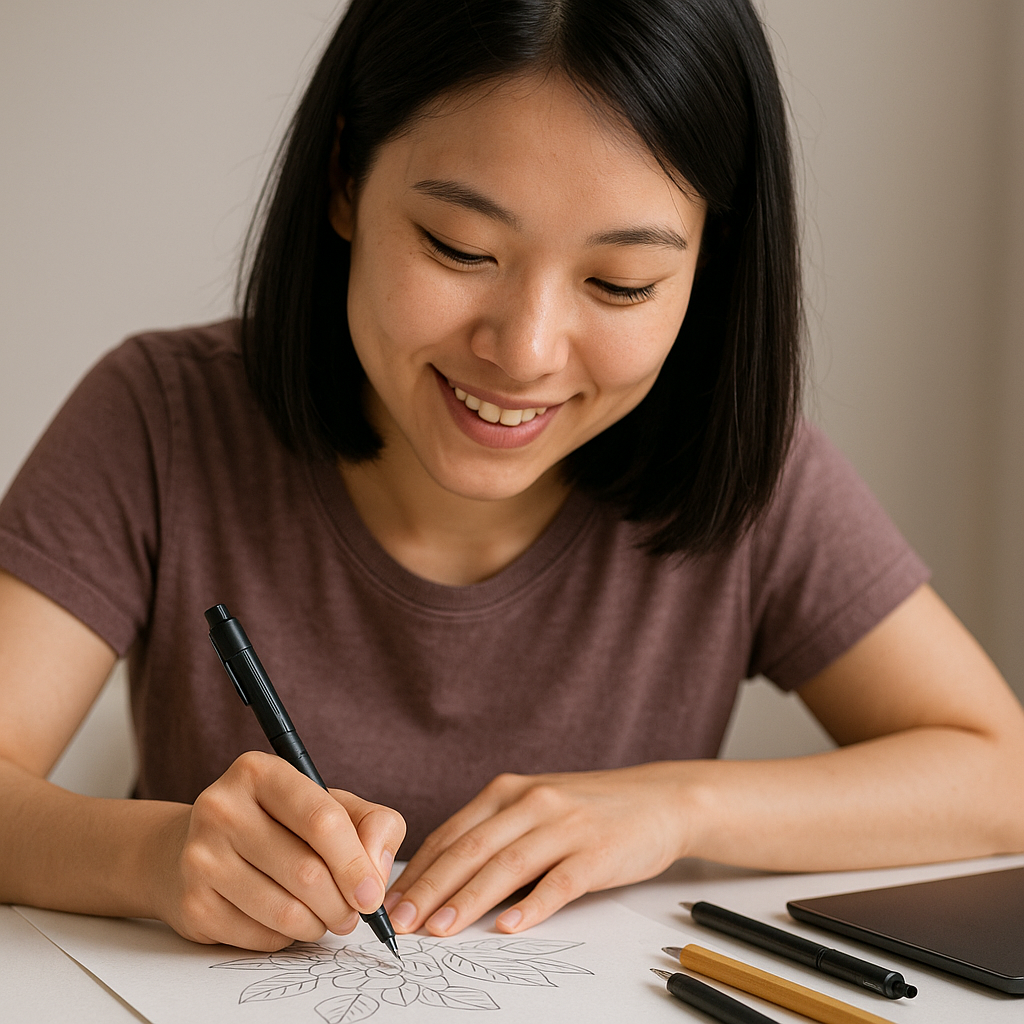
Digital tools offer advantages like unlimited undos and perfect line smoothing, but traditional media provide tactile feedback that many artists prefer.
Building foundational skills
Before attempting complex compositions, develop control and confidence through these exercises:
- line quality practice: draw straight lines, curves, and spirals, focusing on maintaining consistent thickness and smooth motion
- blind contour drawing: look only at your subject (not your paper) while drawing its outline in one continuous line
- cross-contour exercises: draw lines that follow the surface contours of objects to understand three-dimensional form
- varied pressure practice: experiment with how different pressures create diverse line weights
Understanding how to use negative space effectively is crucial. Sometimes what you don’t draw is as important as what you do. Try creating a composition where the white space forms recognizable shapes or contributes meaningfully to the overall image.
Starter project ideas
Begin with manageable subjects that will build confidence while teaching important skills:
- simple household objects like cups, vases, or fruit
- botanical subjects—leaves, simple flowers, or branches
- basic facial features or simplified portraits
- architectural elements like doorways or windows
- abstract patterns based on repeated simple motifs
When starting a new piece, resist the urge to commit immediately to ink. Develop your composition with light pencil first, focusing on capturing proportions and placement. Once satisfied, trace over with your chosen line medium, varying thickness to create hierarchy and emphasis.
Remember that clean, effective line art often involves thoughtful editing—knowing which details to include and which to omit. Beginners typically include too much rather than too little. Challenge yourself to communicate with fewer, more intentional lines.
If you’re struggling to develop your skills or want inspiration, consider exploring wall art prints by style to study how professional artists handle composition, line weight, and negative space.
Common challenges and solutions
Many beginners encounter similar obstacles when learning line art:
- shaky lines: practice slow, deliberate strokes from the shoulder rather than the wrist
- proportional errors: use basic measurement techniques, like holding your pencil at arm’s length
- overworking: know when to stop—sometimes imperfection adds character
- fear of commitment: embrace mistakes as learning opportunities
Consider working in series rather than fixating on creating one perfect piece. This approach reduces pressure and allows you to observe your progression over multiple attempts. Remember that even renowned artists developed their skills through consistent practice rather than innate talent alone.
Conclusion
Line art’s enduring popularity speaks to its fundamental power as a mode of visual expression. From prehistoric cave walls to contemporary digital displays, humans have consistently returned to the elegant simplicity of the line to communicate ideas, emotions, and observations.
What makes this artistic approach particularly relevant today is its versatility and accessibility. In a visually saturated world, the clarity and directness of line art cuts through noise. Its minimalist aesthetic aligns perfectly with contemporary design sensibilities while maintaining connections to artistic traditions spanning centuries.
Whether you’re an aspiring artist wanting to develop foundational skills, a design enthusiast looking to understand visual trends, or simply someone seeking to bring visual interest into your space, line art offers accessible entry points and endless possibilities for exploration and appreciation.
The beauty of line art lies in its simultaneous simplicity and complexity—how a few well-placed lines can capture the essence of a subject, evoke emotion, or transform a space. In stripping away the non-essential, line art reveals what truly matters in visual communication, making it both timeless and perpetually fresh.
Frequently Asked Questions
What is the main purpose of line art in drawing?
Line art emphasizes form and structure using only lines, without shading or dramatic color, making it ideal for clarity, design, or minimalist expression.
Who are famous artists known for line art?
Notable artists include Pablo Picasso, Henri Matisse, Leonardo da Vinci, and modern digital artists bringing the style to new audiences.
What materials can I use to create line art?
Line art can be made with pencils, pens, markers, ink, or digital tools—anything that produces a clear, clean line.
Can line art be used in interior design?
Absolutely! Minimalist line art prints and posters are hugely popular for modern home and office decor due to their elegance and versatility.
Is line art suitable for beginners?
Yes—line art is approachable and provides an excellent way for beginners to build drawing confidence and foundational skills.